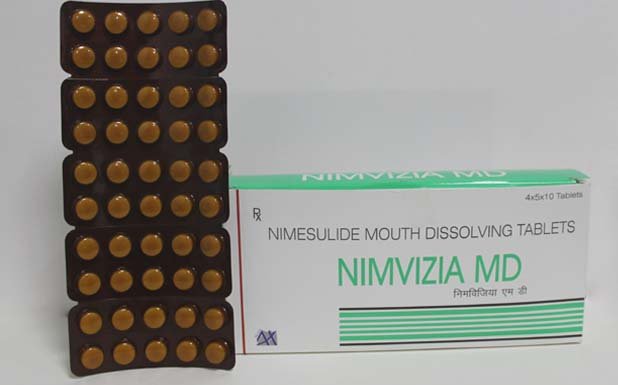
Composition
- Each Uncoated Mouth Dissolving Tablets Contains:
- Nimesulide BP
100 mg
Packing
- 4x5x10
(Blister)
MRP
- 29
Overview
Nimesulide is a sulfonanilide non-steroidal anti-inflammatory drug whose anti-inflammatory analgesic and antipyretic activities have been demonstrated in several widely used animal experimental models.At the recommended dose of 100 mg b.i.d., it is as effective an analgesic and anti-inflammatory agent as classical NSAIDs, and a well-tolerated drug with fewer side effects as evidenced by a number of controlled and non-controlled comparative trials.
Nimesulide appears to exert its therapeutics effects through a variety of mechanisms viz4:
- Selective Cyclooxygenase-2 inhibitor
- Reduced generation of superoxide anions by stimulated polymorphonuclear leucocytes
- Inhibition of platelet aggregation factor synthesis by activated cells
- Scavenger of inactivation of alpha1-protease inhibitor
- Inhibition of histamine release
Indications and Usage
Nimesulide is indicated in reducing pain, fever and inflammatory symptoms of:• Chronic arthritis (Osteoarthritis)
• Respiratory tract infections
• Otorhinolaryngological diseases
• Soft tissues and oral cavity inflammation
• Dysmenorrhoea
• Phlebitis / thrombosis
• Urogenital disease
• Postoperative pain states
• Sports injuries
Warnings
Caution should be exercised in patients with history of stomach problem, high blood pressure, fluid retention, elderly, during pregnancy and breast-feeding.
Other Precautions: Avoid excess dosage.Contraindications
History of allergy to NSAIDs.
History of nasal polyps, angiodema and /or bronchospastic reactivity to any NSAID.
Hypovolaemia/dehydration (>10% total body weight).
Peptic ulcer disease.
Side Effects
Gastrointestinal:- Abdominal discomfort, heartburn, abdominal cramps, nausea, vomiting and diarrhea.
Central Nervous System:- Headache, dizziness and drowsiness.
Genitourinary:- Blood in urine, decrease in urination and kidney failure.
Pharmacology
Pharmacokinetics
Nimesulide is fairly rapidly absorbed from the gastrointestinal tract. The volume of distribution in the post distribution phase for Nimesulide ranges from 0.19 to 0.39 L/kg, indicating that the drug is principally distributed in the extra cellular fluid compartment. Nimesulide is almost exclusively metabolized and cleared by the liver. After oral administration of Nimesulide 100 mg, the apparent mean elimination half-life (t½β) varied from 1.96 to 4.75 hours. Nimesulide is mainly eliminated by the renal route.Interactions
Additive hepatotoxic effects with known hepatotoxins: anti-convulsants (e.g. valproic acid), anti-fungals (e.g. ketoconazole), anti-tuberculous drugs (e.g. isoniazid), tacrine, pemoline, amiodarone, methotrexate, methyldopa, amoxicillin/clavulanic acid. May decrease the oral bioavailability of furosemide and the natriuretic and diuretic response to furosemide. Increased risks of GI and hepatic adverse effects with other NSAIDs, including aspirin. May increase anti- coagulant effect of warfarin. Potentiates the action of phenytoin. May be displaced from binding sites with fenofibrate, salicylic acid, and tolbutamide. Interactions between NSAIDs and lithium, probenecid and ciclosporin, have been documented.Food Interactions: Alcohol increases the risk of hepatic reactions.